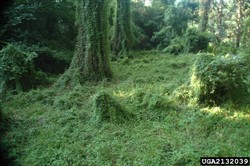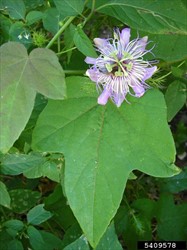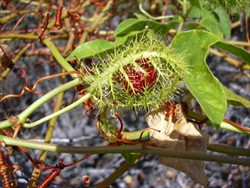- Worldwide distribution. In Australia and most Pacific island countries. Aggressive, fast-growing vine in tropics and subtropics.
- Environmental weed, invading forest edges, coastal vegetation, riverbanks, creeks, and seashores; also, a weed of disturbed sites, wastelands, fences, roadsides, crops (cotton, maize, oil palm, rubber, sugarcane, taro) and pastures. Host of Passionfruit woodiness potyvirus. Unripe fruits poisonous.
- Stems, angular, hairs tipped with smelly liquid. Leaves, alternate, heart-shaped or with 3-5 pointed lobes, margins hairy, stinking when crushed. Long tendrils. Flowers, bisexual, purple and white, five petals, two rows of filaments, five stamens, three styles, surrounded by prickly/hair-like leaves, which later enclose single orange to red fruit with black seeds.
- Spread: by birds, bats. Longer distances as an ornamental, food and medicine.
- Biosecurity: high risk; seed readily available on Internet.
- Biocontrol: None.
- Cultural control: hChemical control: in Australia, triclopyr+ picloram and glyphosate in non-agricultural situations. Use cut stump/paint, basal bark or leaf spray treatments (see full Fact Sheets for details).










